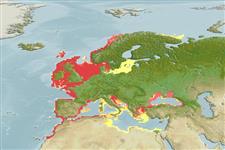Preferred temperature (Ref.
115969): 7.6 - 18.6, mean 10.8 (based on 1452 cells).
Phylogenetic diversity index (Ref.
82804): PD
50 = 1.0000 [Uniqueness, from 0.5 = low to 2.0 = high].
Bayesian length-weight: a=0.00525 (0.00458 - 0.00602), b=3.09 (3.05 - 3.13), in cm Total Length, based on LWR estimates for this species (Ref.
93245).
Niveau trophique (Ref.
69278): 3.1 ±0.28 se; based on food items.
Résilience (Ref.
120179): Haut, temps minimum de doublement de population inférieur à 15 mois (K>0.3; tm=1; tmax=1; Fec = 935).
Fishing Vulnerability (Ref.
59153): Low vulnerability (12 of 100).
